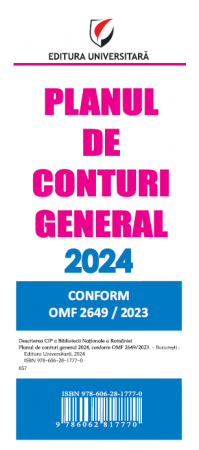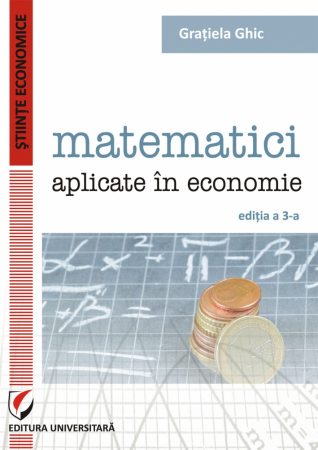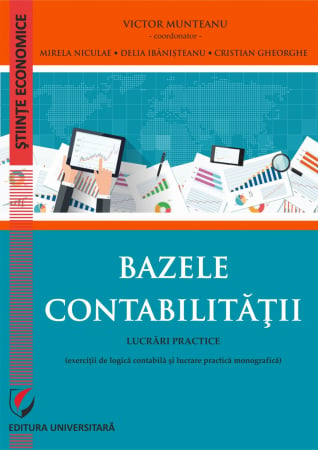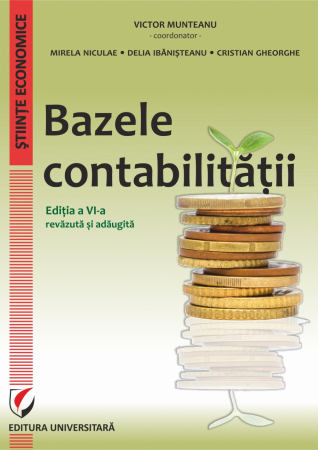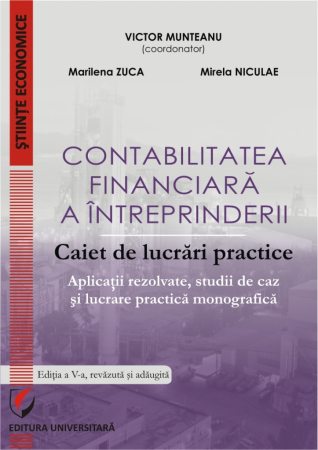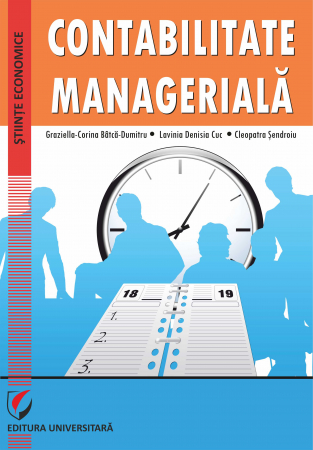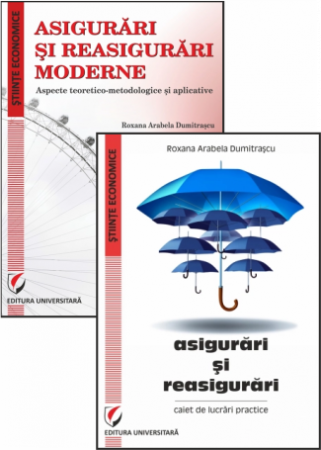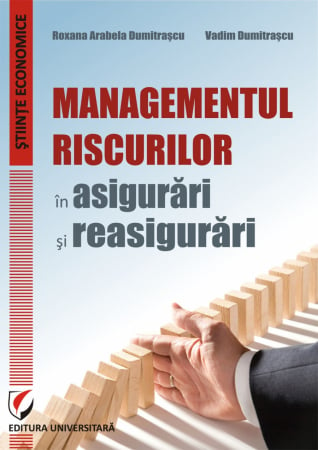Manuscript proposals: [email protected] / 0745 204 115 //// Tracking orders Individuals / Sales: 0745 200 357 / Orders Legal entities: 0721 722 783
6359.png) Theoretical aspects regarding the improvement of the relations with the clients, second edition, revised and added
Theoretical aspects regarding the improvement of the relations with the clients, second edition, revised and added
6359.png)
ISBN: 978-606-28-1448-9
DOI: https://doi.org/10.5682/9786062814489
Publisher year: 2022
Edition: II
Pages: 214
Author: Emilia Pascu
Publisher: Editura Universitară
Product Code:
9786062814489
Do you need help?
0745 200 357
- Description
- Download (1)
- Authors
- Content
- More details
- Reviews (0)
Gaining and retaining a significant number of loyal customers is a strong advantage for any company in increasingly competitive markets because in terms of efficient management customers are a part of the market difficult to access other bidders. In fact, they are the most important source of the company's profit for the present and for the future economic growth.
Initially, meeting the needs of the customer is just a premise of effective marketing. Currently, in the conditions of customers easily switching from one bidder to another, it is naturally necessary to retain them through specific actions and programs, consisting in offering advantages (promotional offers, price reductions, loyalty cards, etc.). Strategies are also needed that focus on triggering customer enthusiasm. Enthusiasm can be determined by personalized offers, resulting in its propagation in the reference groups of the clients, in the center of the strategy of any company being obligatory to find the client.
The economy of the present and certainly that of the following years, presupposes strong and lasting relations with the clients, the way of managing them with the help of the new information technologies being a major element of the increase of the companies' competitiveness.
If the 1990s marked the transition from transactional marketing to relational marketing and as a result focused on achieving as many short-term transactions as possible, in recent years it has been replaced by the philosophy of promoting medium and long term relationships, with all categories of persons and companies that have a direct or indirect interest in the activity of the organization ("stakeholders"). Naturally, the assertion of relational marketing, both conceptually and operationally, has led to a reconsideration of customer relations, a major category of "stakeholders" and a successful management involves action orientation, continuous customer contact, business orientation ‑ key and great value.
Customer relations management (a concept established in the literature and business practice under the name CRM - Customer Relationship Management) has caught the attention of all companies, becoming a field of maximum interest in the development of information technology. In any sector of activity, there is the allocation of significant financial resources for the creation of efficient customer management infrastructures.
In recent years it has become unanimously accepted that CRM is a business strategy, reaching all the functions of companies, especially since the IT solutions of the moment and certainly the future ones support the fulfillment of the objectives in the field of customer relations without representing the essence of the concept. of CRM. In order to ensure the effective and efficient fulfillment of the proposed objectives, the companies have to harmonize the three levels of CRM: strategic, operational and analytical, managing a multitude of facets, from designing strategies, to automating sales, services, marketing and communication activities. until the analysis of the information and the measurement of the organization's performances in the relations with the clients.
Today we are witnessing the orientation of more and more companies towards the development of profitable and long-term relationships with customers, as a way to ensure sustainable development and increase market competitiveness. The emergence as a distinct field of customer relationship management (CRM) has required the creation and development of personalized customer relationships in order to increase the profitability of companies. Customer relationship management thus aiming at the strategic management of customer relations (one of the most important categories of "stakeholders"), based on the use of information technology.
Prior to the advent of customer relationship management, customers were not considered "moving targets" by companies. Currently, the markets are extremely dynamic, with segments and niches whose profile is constantly evolving. Under these conditions, Customer Relationship Management relies on attracting and retaining profitable customers, through the development of long-term relationships and by stimulating customer loyalty, allowing companies to understand customers, to "isolate" the best customer (we want to have a long-term relationship with him), to create a mutually beneficial long-term relationship with them.
The new possibilities offered by the information technology support the substantiation of the most suitable strategies for developing the relations with each client within the companies' portfolio.
Initially, meeting the needs of the customer is just a premise of effective marketing. Currently, in the conditions of customers easily switching from one bidder to another, it is naturally necessary to retain them through specific actions and programs, consisting in offering advantages (promotional offers, price reductions, loyalty cards, etc.). Strategies are also needed that focus on triggering customer enthusiasm. Enthusiasm can be determined by personalized offers, resulting in its propagation in the reference groups of the clients, in the center of the strategy of any company being obligatory to find the client.
The economy of the present and certainly that of the following years, presupposes strong and lasting relations with the clients, the way of managing them with the help of the new information technologies being a major element of the increase of the companies' competitiveness.
If the 1990s marked the transition from transactional marketing to relational marketing and as a result focused on achieving as many short-term transactions as possible, in recent years it has been replaced by the philosophy of promoting medium and long term relationships, with all categories of persons and companies that have a direct or indirect interest in the activity of the organization ("stakeholders"). Naturally, the assertion of relational marketing, both conceptually and operationally, has led to a reconsideration of customer relations, a major category of "stakeholders" and a successful management involves action orientation, continuous customer contact, business orientation ‑ key and great value.
Customer relations management (a concept established in the literature and business practice under the name CRM - Customer Relationship Management) has caught the attention of all companies, becoming a field of maximum interest in the development of information technology. In any sector of activity, there is the allocation of significant financial resources for the creation of efficient customer management infrastructures.
In recent years it has become unanimously accepted that CRM is a business strategy, reaching all the functions of companies, especially since the IT solutions of the moment and certainly the future ones support the fulfillment of the objectives in the field of customer relations without representing the essence of the concept. of CRM. In order to ensure the effective and efficient fulfillment of the proposed objectives, the companies have to harmonize the three levels of CRM: strategic, operational and analytical, managing a multitude of facets, from designing strategies, to automating sales, services, marketing and communication activities. until the analysis of the information and the measurement of the organization's performances in the relations with the clients.
Today we are witnessing the orientation of more and more companies towards the development of profitable and long-term relationships with customers, as a way to ensure sustainable development and increase market competitiveness. The emergence as a distinct field of customer relationship management (CRM) has required the creation and development of personalized customer relationships in order to increase the profitability of companies. Customer relationship management thus aiming at the strategic management of customer relations (one of the most important categories of "stakeholders"), based on the use of information technology.
Prior to the advent of customer relationship management, customers were not considered "moving targets" by companies. Currently, the markets are extremely dynamic, with segments and niches whose profile is constantly evolving. Under these conditions, Customer Relationship Management relies on attracting and retaining profitable customers, through the development of long-term relationships and by stimulating customer loyalty, allowing companies to understand customers, to "isolate" the best customer (we want to have a long-term relationship with him), to create a mutually beneficial long-term relationship with them.
The new possibilities offered by the information technology support the substantiation of the most suitable strategies for developing the relations with each client within the companies' portfolio.
-
Theoretical aspects regarding the improvement of the relations with the clients, second edition, revised and added
Download
EMILIA PASCU
INTRODUCTION / 9
Chapter 1 - THE PLACE OF CUSTOMERS WITHIN THE COMPANY / 12
1.1. Customer definition / 13
1.2. Categories of customers / 17
1.3. Customer profile / 25
1.4. Identifying the wishes, needs and expectations of customers / 26
1.5. Customer satisfaction / 30
CONTROL TESTS / 41
Chapter 2 - COMMUNICATION - IMPORTANT CUSTOMER RELATIONSHIP VECTOR / 47
2.1. Understanding communication / 50
2.2. Communication processes / 51
2.3. Components of the communication process / 53
2.4. Forms of communication / 54
2.5. Communication within the company / 57
2.6. The Internet - the means of communication / 62
CONTROL TESTS / 64
Chapter 3 - DEFINITIVE ELEMENTS OF CUSTOMER BUYING BEHAVIOR / 67
3.1. The steps of the purchasing decision process / 69
3.2. Structure and typology of purchasing decisions / 80
3.3. Directly observable influences on the customer's buying behavior / 87
3.4. Endogenous influences on the actual behavior of the client / 92
3.5. Exogenous influences on the customer's buying behavior / 94
3.6. Customer requirements and buying behavior / 97
3.7. Customer loyalty and the effects of loyalty / 98
CONTROL TESTS / 102
Chapter 4 - CUSTOMER RELATIONSHIP MANAGEMENT - A TOOL FOR SUCCESS / 111
4.1. The emergence of customer relationship management / 111
4.2. Defining customer relationship management (CRM) / 115
4.3. Customer Relationship Management Objectives / 121
4.4. Recommended Strategies for Customer Relationship Management / 128
4.5. Investitia in Customer Relationship Management / 131
4.6. Advantages of implementing CRM for companies / 135
4.7. Customer Relationship Performance Indicators / 137
CONTROL TESTS / 145
Chapter 5 - COMPLAINTS MANAGEMENT / 155
5.1. General presentation / 155
5.2. Principles of handling complaints / 161
5.3. Stages of the complaint handling process / 166
5.4. Complaints management performance / 172
CONTROL TEST / 176
Chapter 6 - ETHICAL RELATIONS WITH CUSTOMERS / 179
6.1. Ethical principles used in business / 181
6.2. Attributes of the observance of the ethical standards by the personnel of the organization / 185
6.3. Values and countervalues in ethics / 195
6.4. Ethics within the company / 199
CONTROL TEST / 206
BIBLIOGRAPHY / 209
Chapter 1 - THE PLACE OF CUSTOMERS WITHIN THE COMPANY / 12
1.1. Customer definition / 13
1.2. Categories of customers / 17
1.3. Customer profile / 25
1.4. Identifying the wishes, needs and expectations of customers / 26
1.5. Customer satisfaction / 30
CONTROL TESTS / 41
Chapter 2 - COMMUNICATION - IMPORTANT CUSTOMER RELATIONSHIP VECTOR / 47
2.1. Understanding communication / 50
2.2. Communication processes / 51
2.3. Components of the communication process / 53
2.4. Forms of communication / 54
2.5. Communication within the company / 57
2.6. The Internet - the means of communication / 62
CONTROL TESTS / 64
Chapter 3 - DEFINITIVE ELEMENTS OF CUSTOMER BUYING BEHAVIOR / 67
3.1. The steps of the purchasing decision process / 69
3.2. Structure and typology of purchasing decisions / 80
3.3. Directly observable influences on the customer's buying behavior / 87
3.4. Endogenous influences on the actual behavior of the client / 92
3.5. Exogenous influences on the customer's buying behavior / 94
3.6. Customer requirements and buying behavior / 97
3.7. Customer loyalty and the effects of loyalty / 98
CONTROL TESTS / 102
Chapter 4 - CUSTOMER RELATIONSHIP MANAGEMENT - A TOOL FOR SUCCESS / 111
4.1. The emergence of customer relationship management / 111
4.2. Defining customer relationship management (CRM) / 115
4.3. Customer Relationship Management Objectives / 121
4.4. Recommended Strategies for Customer Relationship Management / 128
4.5. Investitia in Customer Relationship Management / 131
4.6. Advantages of implementing CRM for companies / 135
4.7. Customer Relationship Performance Indicators / 137
CONTROL TESTS / 145
Chapter 5 - COMPLAINTS MANAGEMENT / 155
5.1. General presentation / 155
5.2. Principles of handling complaints / 161
5.3. Stages of the complaint handling process / 166
5.4. Complaints management performance / 172
CONTROL TEST / 176
Chapter 6 - ETHICAL RELATIONS WITH CUSTOMERS / 179
6.1. Ethical principles used in business / 181
6.2. Attributes of the observance of the ethical standards by the personnel of the organization / 185
6.3. Values and countervalues in ethics / 195
6.4. Ethics within the company / 199
CONTROL TEST / 206
BIBLIOGRAPHY / 209
Gaining and retaining a significant number of loyal customers is a strong advantage for any company in increasingly competitive markets because in terms of efficient management customers are a part of the market difficult to access other bidders. In fact, they are the most important source of the company's profit for the present and for the future economic growth.
Initially, meeting the needs of the customer is just a premise of effective marketing. Currently, in the conditions of customers easily switching from one bidder to another, it is naturally necessary to retain them through specific actions and programs, consisting in offering advantages (promotional offers, price reductions, loyalty cards, etc.). Strategies are also needed that focus on triggering customer enthusiasm. Enthusiasm can be determined by personalized offers, resulting in its propagation in the reference groups of the clients, in the center of the strategy of any company being obligatory to find the client.
The economy of the present and certainly that of the following years, presupposes strong and lasting relations with the clients, the way of managing them with the help of the new information technologies being a major element of the increase of the companies' competitiveness.
If the 1990s marked the transition from transactional marketing to relational marketing and as a result focused on achieving as many short-term transactions as possible, in recent years it has been replaced by the philosophy of promoting medium and long term relationships, with all categories of persons and companies that have a direct or indirect interest in the activity of the organization ("stakeholders"). Naturally, the assertion of relational marketing, both conceptually and operationally, has led to a reconsideration of customer relations, a major category of "stakeholders" and a successful management involves action orientation, continuous customer contact, business orientation ‑ key and great value.
Customer relations management (a concept established in the literature and business practice under the name CRM - Customer Relationship Management) has caught the attention of all companies, becoming a field of maximum interest in the development of information technology. In any sector of activity, there is the allocation of significant financial resources for the creation of efficient customer management infrastructures.
In recent years it has become unanimously accepted that CRM is a business strategy, reaching all the functions of companies, especially since the IT solutions of the moment and certainly the future ones support the fulfillment of the objectives in the field of customer relations without representing the essence of the concept. of CRM. In order to ensure the effective and efficient fulfillment of the proposed objectives, the companies have to harmonize the three levels of CRM: strategic, operational and analytical, managing a multitude of facets, from designing strategies, to automating sales, services, marketing and communication activities. until the analysis of the information and the measurement of the organization's performances in the relations with the clients.
Today we are witnessing the orientation of more and more companies towards the development of profitable and long-term relationships with customers, as a way to ensure sustainable development and increase market competitiveness. The emergence as a distinct field of customer relationship management (CRM) has required the creation and development of personalized customer relationships in order to increase the profitability of companies. Customer relationship management thus aiming at the strategic management of customer relations (one of the most important categories of "stakeholders"), based on the use of information technology.
Prior to the advent of customer relationship management, customers were not considered "moving targets" by companies. Currently, the markets are extremely dynamic, with segments and niches whose profile is constantly evolving. Under these conditions, Customer Relationship Management relies on attracting and retaining profitable customers, through the development of long-term relationships and by stimulating customer loyalty, allowing companies to understand customers, to "isolate" the best customer (we want to have a long-term relationship with him), to create a mutually beneficial long-term relationship with them.
The new possibilities offered by the information technology support the substantiation of the most suitable strategies for developing the relations with each client within the companies' portfolio.
Initially, meeting the needs of the customer is just a premise of effective marketing. Currently, in the conditions of customers easily switching from one bidder to another, it is naturally necessary to retain them through specific actions and programs, consisting in offering advantages (promotional offers, price reductions, loyalty cards, etc.). Strategies are also needed that focus on triggering customer enthusiasm. Enthusiasm can be determined by personalized offers, resulting in its propagation in the reference groups of the clients, in the center of the strategy of any company being obligatory to find the client.
The economy of the present and certainly that of the following years, presupposes strong and lasting relations with the clients, the way of managing them with the help of the new information technologies being a major element of the increase of the companies' competitiveness.
If the 1990s marked the transition from transactional marketing to relational marketing and as a result focused on achieving as many short-term transactions as possible, in recent years it has been replaced by the philosophy of promoting medium and long term relationships, with all categories of persons and companies that have a direct or indirect interest in the activity of the organization ("stakeholders"). Naturally, the assertion of relational marketing, both conceptually and operationally, has led to a reconsideration of customer relations, a major category of "stakeholders" and a successful management involves action orientation, continuous customer contact, business orientation ‑ key and great value.
Customer relations management (a concept established in the literature and business practice under the name CRM - Customer Relationship Management) has caught the attention of all companies, becoming a field of maximum interest in the development of information technology. In any sector of activity, there is the allocation of significant financial resources for the creation of efficient customer management infrastructures.
In recent years it has become unanimously accepted that CRM is a business strategy, reaching all the functions of companies, especially since the IT solutions of the moment and certainly the future ones support the fulfillment of the objectives in the field of customer relations without representing the essence of the concept. of CRM. In order to ensure the effective and efficient fulfillment of the proposed objectives, the companies have to harmonize the three levels of CRM: strategic, operational and analytical, managing a multitude of facets, from designing strategies, to automating sales, services, marketing and communication activities. until the analysis of the information and the measurement of the organization's performances in the relations with the clients.
Today we are witnessing the orientation of more and more companies towards the development of profitable and long-term relationships with customers, as a way to ensure sustainable development and increase market competitiveness. The emergence as a distinct field of customer relationship management (CRM) has required the creation and development of personalized customer relationships in order to increase the profitability of companies. Customer relationship management thus aiming at the strategic management of customer relations (one of the most important categories of "stakeholders"), based on the use of information technology.
Prior to the advent of customer relationship management, customers were not considered "moving targets" by companies. Currently, the markets are extremely dynamic, with segments and niches whose profile is constantly evolving. Under these conditions, Customer Relationship Management relies on attracting and retaining profitable customers, through the development of long-term relationships and by stimulating customer loyalty, allowing companies to understand customers, to "isolate" the best customer (we want to have a long-term relationship with him), to create a mutually beneficial long-term relationship with them.
The new possibilities offered by the information technology support the substantiation of the most suitable strategies for developing the relations with each client within the companies' portfolio.
If you want to express your opinion about this product you can add a review.
write a review

![Theoretical aspects regarding the improvement of the relations with the clients, second edition, revised and added [1] Theoretical aspects regarding the improvement of the relations with the clients, second edition, revised and added [1]](https://gomagcdn.ro/domains/editurauniversitara.ro/files/product/large/pascu-emilia_aspecte-privind-imbunat-rel-cu-clientii-ed2_bt-6872-7501.jpg)
